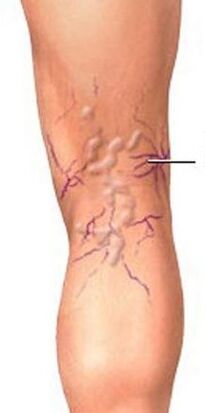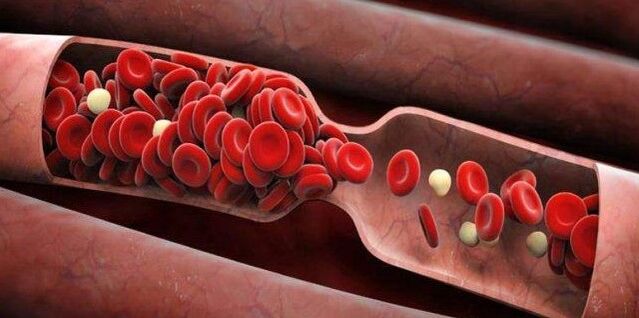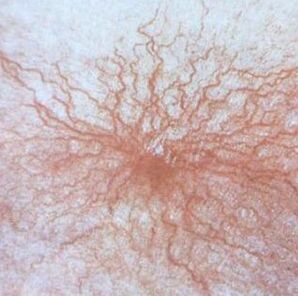Varicose veins are a pathological process characterized by an increase in the lumen of the blood vessels that provide blood flow, thinning the walls and deformations until the formation of nodes and ruptures. For the sake of anatomy, the disease is most often found in the lower veins.

The external signs of varicose veins are not an unusual aesthetic problem: the vascular "star", which highlights the dark shade - only symptoms of blood circulation disorders, are full of life -threatening consequences.
The mechanism of development of varicose veins in the legs
The mechanism of development of varicose veins is associated with a decrease in venous valve function. They are subject to large mechanical loads, therefore, under the influence of genetic factors, hormone jumps, inflammation in the lower back and lower loads, weakening and not prevents the opposite blood flow. Inflammation occurs in the background of stagnant phenomena associated with high blood viscosity, hypodynamia or high standing in standing or sitting position.
Excessive blood pressure on the vein wall changes its shape, inhibiting the function of the muscles and walls of the nerve veins, which gives a stable tone. Blood vessels, incredible blood vessels and inflammation of their walls often lead to the formation of blood cell accumulation, which overlaps with vein lumen.
Therefore, varicose veins in the feet are not shallow problems associated with mechanical damage to subcutaneous vessels or temporary phenomena, but deeper circulatory disorders developed in patients exposed to diseases under the influence of risk factors.
The drug therapy is intended:
- Toning blood vessel wall;
- the removal of inflammation;
- blood dilution;
- Prevention of blood clots.
In the absence of adequate treatment, what is dangerous to varicose veins from the lower leg can be a reality for each patient with the disease.
In 80% of cases, women experience varicose veins in the feet. The main thing that varicose veins are dangerous in women is the possible early development of the disease due to hormone jumps during puberty or pregnancy. During fetal bearings, only soft therapy may have no teratogenic effects. Extra foot loads, lack of intensive treatment and burden during experiment can stimulate disease disorders.
What threatens varicose veins?
As a rule, thrombophlebitis and other harmful consequences of varicose veins occur in the 3rd stage of vein deficiency. Symptoms of the final stage of vascular failure:
- persistent severity in the feet;
- swelling;
- Darkness of the skin in the ankle area.

Dermatitis, eczema, and skin inflammation cause blood circulation in the limbs.
Telengiectasia is the most dangerous consequence of vein deficiency. This condition is characterized by the appearance of vascular and "stars", which is accompanied by edema, fatigue, common occurrence of numbness and night seizures in the caviar. Aesthetic defects are one of the reasons why women often turn to phlebology in the early stages of varicose veins. In order to save beautiful feet, patients care about their health.
Subcutaneous bleeding and vein gap
Thrombophlebitis - thrombosis against the background of inflammation of the venous wall and blood stagnation in the expanded vessel. The disease developed is characterized by compaction and pain of palpation (examining) the affected vessels, as well as the redness of the skin around the thrombus. Thrombophlebitis develop about 25% of patients who have diagnosed varicose veins. Blood clots in the surface veins have low dangers of separation with harm to health, however, in terms of promoting blood clots along subcutaneous or hollow vessels, admitted to hospitals immediately.
Deep thrombosis is much more dangerous than varicose veins and thrombophlebitis. The blood clots formed in the vessels in the lower leg can separate and clog the pulmonary artery, resulting in death. Symptoms of deep vein thrombosis are severe edema of the limbs that occur in a short time, and a sharp rupture of the calf or femoral muscles. The spread of pathological processes to vessels in the lower lower leg can be seen in the final stages of varicose veins.
Trophic ulcer is a deep dermis defect that is formed at a later stage due to impaired blood flow to the skin surface. It represents long -term pain, which is difficult to give to therapy.
Lower foot vein varicosis is one of the risk factors in the development of such pathology in other small pelvis male and female pelvis.
Medical Steps against the consequences of varicose veins
Treatment of varicose vein complications in the feet, as a rule, begins with drug therapy for major diseases.
To reduce blood vessel deformation, which develops due to decreased tone, venotonic based on hesperidine, diosmine, esculin, and other prescribed.

With inflammation of the vein wall, the medicines are prescribed from the anti -non -ssteroidal drug group in the form of tablets and gels. Oral acceptance of anti -anti -medication is recommended for thrombophlebitis.
Reduction of blood viscosity is achieved using local ointment with anticoagulant components and routine derivative and methylxanthin oral intake, which has antiagregantamic properties.
The manifestation of the surface of the varicose veins in the legs (including telangiectasia) is eliminated by sclerotherapy (attaches to the affected vessel wall using special drugs). This procedure does not cause significant harm to health and does not violate blood flow, as during recovery, the function of the surface vein crosses the vessel.
With deep vein thrombosis, bed breaks are prescribed, intravenous administration of anticoagulant and anti -bark with blood viscosity control. Surgical treatment for vessel thrombosis and thrombophlebitis (including large subcutaneous veins) is indicated if there is a high risk of pulmonary artery blockage. Trophic ulcer treatment aims to stimulate wound healing and major disease therapy.
Precaution
Prevention of varicose complications includes the following steps:
- wearing compression linen;
- Physiotherapy physical education;
- Exceptions sitting and standing long;
- The choice of shoes with heels is from 2. 5. to 6 cm;
- Dietary enrichment with fiber and sources of vitamins B1, C, E and P;
- Compliance with water norms (2. 5 l);
- different water procedures;
- rejection of hormone contraceptives (COC effects on female body including increased risk of thrombosis);
- People's methods (compressing, bathing, etc. ).
Early diagnosis of varicose veins, timely treatment and decrease in the effects of risk factors preventing the development of disease complications. The use of slightly invasive surgical methods in some cases eliminates not only aesthetic problems, but also the probability of deteriorating pathological processes.


















